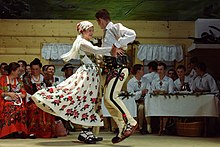Użytkownik:Marta Malina Moraczewska/EtnoKarpaty-1-notatki
Carpathian Ethnography Project

Initial assumptions and plan
edytujSchedule of field trip
edytujThe Museum was responsible for setting up the team schedule, consisting of three main areas:
- Meetings at local museums and open-air museums
- Meetings with local craftsmen and artisans
- Public (or half-public, eg. a local folk workshop for young people) events and social gatherings, festivals, etc.
Team coordination
edytuj- Klara Sielicka, main Museum coordinator, posted a preliminary schedule detailing a list of meetings, and locations, for each day of the trip, on Wiki, for all team members to find and take note.
- Team members communicated through the mailing list dedicated to the project, and through email and phone – Klara Sielicka (Museum) and Marta Moraczewska (Wikimedia) being two joint coordinators informing everyone of times, dates and organisational details.
- We made a list of photo equipment necessary to take good pictures of items and clothing, and took test pictures before trip #1.
- Organisational: Marta (WMPL) and Klara (Museum) were in charge of collecting invoices for fuel, meals and accommodation.
The trip
edytujStructure of work days
edytuj- The team visited 2 locations - Beskid and Podhale - 2 places of accommodation (3 nights + 2 nights).
- In each location the team visited 2 to 3 places or people every day.
- Working hours were on average from 9AM to 6PM (but in some cases, recording at night or skipping lunch!)
- We had limited time for each place. This became an issue in larger museums, where the team divided into mini sub-teams: filming/interview team; photography team; and reference team (scanning books).
Visited locations and museums
edytujThe team visited:
- The outdoor Mass of the Assumption of Mary (święto Matki Boskiej Zielnej) with Beskid folklore musicians (photos, film)
- Outdoor celebrations following the Mass with folklore group (photos, film)
- The workshop and dressing room of Jadwiga Jurasz, artisan tailor, maker of garments modeled on old Beskid designs (photos)
- The workshop at local cultural centre led by folk music instruments craftsman (film)
- Artisan maker of kierpce shoes (photos, film)
- Outdoor museum in Milówka (photos)
- The City Museum in Żywiec (photos, book scans, workshop) – large museum, no Wikipedia entry in English, added to list
- The Dom Ludowy in Bukowina Tatrzańska (photos)
- The Tatra Museum in Zakopane (photos, film, book scans) – large museum, no Wikipedia entry in English
- The Zagroda Korkoszów Museum in Podhale – outdoor museum, no Wikipedia entry (already on list)
- Artisan maker of Podhale jewelry (film, photos)
We took around 3000 images, out of which we plan to upload 300 or more of the highest-quality ones. Museum filmmaker recorded interviews and scenes as planned.
Follow-up
edytuj- Articles: we're updating the article list to include additional missing articles identitified by Museum team during the trip.
- Images: we run most photos through GIMP or similar programs to end up with good quality images.
- Example standard description of a photo
- Apart from articles, in case of visited museums, we will add new Commons Institution and Creator templates
- Once the extended article list is ready and we upload more images, we'll notify the wider community to participate in editing.
Notes
edytuj- Many article ideas beyond the ones listed in the grant became apparent during the course of the trip. The ethnographers in the field could pinpoint many missing or barely existing articles, in different languages.
- For events, camera and video camera. For cultural centres and museums - photographic mobile studio proved useful to achieve decent quality images.
- Contacts were established in largest local museums, which may well result in more content (director of the Tatra Museum turned out to be a beginner Wikipedian; local photographers are interested in CC licenses)
- Presence of specialists from another Museum together with Wikipedians made it easier to convince museum staff locally to help the project effort
- Museum staff allowed the team into archives and allowed us to photograph catalogue cards to help with Commons descriptions; for small museums, several hours of photography results in mini-digitisation, and the museum can reuse the images on its own website and other materials. This might encourage the museums to continue releasing images onto Wikimedia Commons.
- Visits and direct contact also help in terms of gathering good sources - Museums allow the team to scan parts of books from their library; local bookshops and libraries are the place to find rare subject literature. We found taking a scanner along was very useful.
Article list for Poland: Beskid and Podhale
edytujEnglish
- National costumes of Poland
- Folk art in Poland
- Folk costume
- Glass painting in Poland
- Folk wood carving in Poland
- Józef Janos
- Jędrzej Wowro
- Tatra Museum in Zakopane
- Żywiec City Museum
- Folklore of Beskids
- Parzenica
- Kierpce
Polish
- Stroje ludowe w Polsce (equivalent to "National costumes of Poland")
- Polska sztuka ludowa
- Strój ludowy
- Pasterstwo w Karpatach
- Muzeum Tatrzańskie im. dr Tytusa Chałubińskiego w Zakopanem
- Category:Polscy twórcy ludowi
- Redyk
- Wypas
- Kierpce
Articles and categories to check:
edytuj(to be continued)